The Broken Hydrological (Water) Cycle.
Summer is always a rather slow time for exchanging vetiver information – a time to relax and reflect. I have been re-reading Charles Massy’s book “Call of the Reed Warbler” (available from e.Books.com). It makes an interesting read (focusing primarily on his own country, Australia) about landscapes that were once in balance with nature, but, since colonization and the introduction of European agricultural methods, have been changed and destroyed, particularly the soils and related water balances. Massy shows how some Australians and others are finding ways to make correction. The crux of the problem is a defunct water cycle (and how/why it became defunct) that results in soil degradation, erosion, flooding. and often huge expenditures in mechanical/industrial equipment and chemicals to assure food production.
Functioning and efficient water cycles at landscape level greatly enhance the capacity to cope with the increasing advent of extreme weather conditions, and together with other “natural” practices improve soil health, reduce risk and the dependency on costly inorganic fertilizers, chemical pesticides, and associated massive and expensive farm machinery. Farm costs and debt can be reduced, and crop yields maintained. Some may not agree with all in the book, but it makes one think. Vetiver grass was not part of the solution for these Australian farmers, but we can envisage how vetiver could be used in nearly every initiative to reinforce some of the corrective actions he describes. These new ideas and initiatives were mainly developed by farmers – the very people whose future depends on the outcome. Australia is a semi arid country with low rainfall – other countries have similar climatic problems – they face “broken” water cycles, degraded soils, crop and livestock stress, and more, at this time of climate change. Change is a slow process, we need to act now, this book might help you develop some plans and actions.

A salute to an incredible user and promoter of the Vetiver System in Latin America
Yorlene Cruz Chaves of Costa Rica is a long time user and promoter of the Vetiver System. She is a Board member and Director of TVNI, the coordinator of the Costa Rica Vetiver Network (Sistema Vetiver Costa Rica (4.6K followers), and a very active member of Vetiver Latina. She is an engineer by profession. Yorleny is the moderator of Virtual LatinAmerica Conversation , a monthly Zoom participatory conversation about vetiver directed at the Spanish speaking Vetiver community in south and central America. She also has a regular podcast, Vetiver Vital, on Spotify. (Spotify/Vetiver Vital). Her commitment, promotion and quality of bioengineering applications has over the years been outstanding – we, the Vetiver Community, are proud of her, and thank her for her contributions to the expansion of the Vetiver System.
Feedback and Opinion
This month I thought I would highlight some of the feedback from vetiver related social platforms. These are the people from around the world who are using vetiver for different applications, some of whom are trying out new designs and applications.
Myanmar Vetiver Network – Enhancing Tree Seedling Survival (Facebook – 4.8K members)

Over the years we have seen the growth of the Myanmar Vetiver Network under the leadership of Thane Mor Thein Maw expand into a group now using a wide range of vetiver applications. A recent post shows an initiative by Dr. Daw Than Than Sein (professor of Geology at Yangon University) to enhance, without irrigation, the growth of shade trees in community parks located in dry arid highlands of Myanmar. She plants 2 slips of vetiver with each tree seedling (6 inches and 12 inches from the tree). She found that over a 28 months testing period that tree survival without vetiver was low, but with vetiver all tree seedlings survived. She has applied this technique to 10,000 trees (including sandalwood, myrrh, tamarind). She has a vetiver nursery, and next year 300,000 slips will be available for distribution. She sets out some of the benefits of applying vetiver next to a young tree seedling:
# protects seedling against termite damage.
# Every 15 days, the grass regrowth is cut and used as mulch (decomposing mulch=soil fertility improvement).
# Deep Vetiver root penetration resulting in increased water infiltration during the rainy season. During the summer, the water needed for the young trees will be regenerated.
# Because the worms came soon after vetiver was planted the soil is improving.
(above text extracted from a not very good Google Translation of the original Myanmar text)
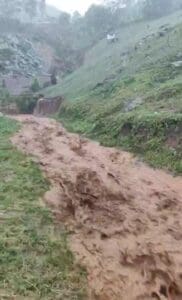
The Philippines – Mount Apo Philippines Vetiver System Farming, Soil/Water Conservation Group – a new group – 365 members
Allan Amps , a community leaders and business man in the Davao area of the Philippines is leading an initiative to reduce flood damage and erosion on Mt. Apo. — a slow and frustrating task. Agricultural development on Mt. Apo has in recent years expanded, even into the Mt Apo National Park, contrary to regulations. Tropical forests have been cut down, the water cycle destroyed, and conservation practices are not common, as a result there is a major erosion and flooding problem from the head of the watershed, high on Mt Apo, to the sea. This video of a motorcycle race on the farmed slopes of Mt Apo provides an interesting view of the mostly unprotected and steep farmlands. Allan lives in the lowlands, and every year his house is flooded to a meter or more. 18 months ago he decided something must be done to put right so he became an “activist”, set up a vetiver nursery and started working with farmers and city/town administrators. He never realized just how difficult it would be introducing a new technology to the area. This video shows just one example of the problems communities face when there are no conservation practices in place.
Nepal – Bio Engineering Management and Research Centre (BMRC)

Binod Neupane who is the leader of BRMC (a new Nepali professional vetiver focused service organization employing engineers, geologists, and agronomists) wrote to say that he is working in the remote Solukhumbu district (near Mt. Everest) in Nepal. Vetiver Technology is being used in hydro-power project related landslide areas. The area has low temperature and diversified soil characteristics. Vetiver.
“In this remote region of Nepal, the work we are engaged in is incredibly demanding and labor intensive, and undeniably crucial program. The effective management of landslides is of primary importance. Our team is dedicated to this essential task. Vetiver technology plays a pivotal role in stabilizing slopes, managing river erosion, and preventing road degradation in Nepal. I will be delving into the intricacies of soil composition, climate factors, and the application of vetiver technology in my writing. Our organization Bio Engineering Management and Research Centre (BMRC), Nepal is involved in this work”.
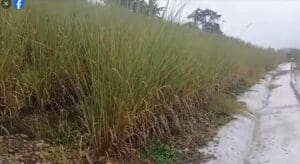
Kathmandu-Terai/Madhesh Expressway. Fast Track, Nepal – video
Binod was involved in the slope stabilization of the Kathmandu-Terai/Madhesh Fast Track road. He assessed the runoff factor, and identified locations for planning countermeasures and hedges. This road impacts the Majhi community land and houses. During his time there, the male, female, and children of the community approached him with concerns about controlling/stabilizing the slope. It took a lot of work to convince them of the value of vetiver grass. They inquired about using Vetiver Grass Technology, and he assured them that it was possible. He implemented Vetiver Technology on the slope and its surroundings. The situation has now improved significantly. He thinks that the government of Nepal needs to manage (create policy) for this sustainable technology for road slope stabilization.
He has found that the Vetiver System produces superior results for slope anchoring in that location, and that when designing vetiver applications on slopes Vetiver technology should address issues such as erosion control, runoff, infiltration, and percolation, all crucial elements
Discussion continues on the issue of inline vetiver plant spacing .. “on steep shallow slip potential slopes with a potential to slide, there might well be a case to plant vetiver further apart. On such slopes vetiver can (1) increase shear strength of the slope soil … wider spacing say 25 cm will still results in a large root mass and improved shear strength (2) reduce hydraulic pressures in the slope by reducing the amount of runoff infiltration. Dense hedgerows increase infiltration, and may result in increased hydraulic pressures, where as wider spacing, especially in the first few years, will allow more runoff reducing hydraulic pressures – with potential further reductions of hydraulic pressures through vetiver related evapotranspiration”.
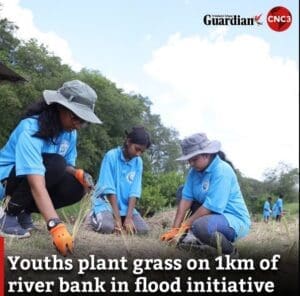
Trinidad and Tobago Community programs stabilizing riverbanks using vetiver grass
In a bid to combat flooding and preserve wildlife in the Woodland plains, young volunteers from the Sustainable Climate Resilience Initiative have started planting one kilometre of vetiver grass along the banks of the New Cut Channel in South Oropouche. For more, see this Guardian article
Kenya Vetiver Network – Regenerative Agriculture with Vetiver – Facebook – 382 members.

Caleb Omolo of Rongo, Kenya is a leader in regenerative agriculture for small and poor farmers in western Kenya. He has helped many farmers move into regenerative practices involving the use of Vetiver grass. Recently he wrote
“Today we were fortunate to receive Mr Eliud Ekadeli from Turkana county’s Department of Agriculture and Land Reclamation who came to learn about vetiver grass in regenerative farming and agroecology.
Mr Eliud explained to us that Turkana is losing a lot of top soil due to soil erosion, so he came to find howto restore the degraded land in Turkana by switching from monoculture to vetiver regenerative farming a method I have been practicing in Migori county for over 15 years.”
Caleb uses bees as part of his farm practices: “When you keep bees in your ecosystem the yield of fruit trees increase, as you can see from this photo of flowering mango trees We keep the apiary underneath the mango tree. The mangoes provide the shade for the bees and the bees in return help with the pollination so both bees and mangoes work together”. When establishing mangoes and other fruit trees vetiver can provide a vital role in improving tree growth and protection against termite and other insect damage.
“Vetiver grass as sanctuary for chickens . This system (vetiver and pumpkins) is now six months old. It was designed to rear chickens in environmental friendly micro climate, and to protect the chickens from flying predators that take young chicks . The banana leaves provides protection for the chickens against the heat from direct sun , the vetiver mulch attracts many types of insects including termites”.

Peter Kingori (Trees For the Future) writes that TFF is planning that 18,000 farmers will be using vetiver by the end of the year and that TFF plans to have 90,000 farmers with vetiver by 2030. He also has shared an image of growing vetiver (in this case a nursery site) with purple vetch Vicia benghalensis. Vetiver provides for a stiff frame for the vetch to grow on and appears to provide additional moisture enhancing vetch growth. Vetch has 10-20% protein content – combined with vetiver it might make a very good biomass feed for livestock as well of course an excellent mulch. It should certainly be useful to carry out some management trials (total biomass production, cutting practices, nutritional values, impact on vetiver and vice versa). More about purple vetch.
USA- Hawaii – Vetiver and Permaculture

Vetiver for soil and water conservation on Maui, Hawaii. A short (2 minute) video from Evan Ryan.He is a practicing permaculturist on Maui. His video shows intensive use of vetiver hedges for soil erosion control. Vegetative barriers consist of permanent strips of stiff, dense vegetation established along the general contour of slopes or across concentrated flow areas….

Spain – Murcia Province – Establishing Vetiver in Arid areas
Tony Cooper. “It’s been a long time since my last post but here are some updated photos. So it looks like vetiver will survive here even with cold winter nights -10C & long periods of drought (only 220mm of rain last year). Just to note soil is very hard almost cement like until wet & also 1m down is solid bedrock so doesn’t grow as fast due to minimal supplementary watering”.
Ecuador – A Perfect Vetiver Application!

A good example of ecological management in Ecuador combining vetiver hedges for soil and water conservation, and its leaves as mulch for weed control, moisture retention and organic soil formation. Congratulations Marco Antonio.

India
Rural Roads — Syed Nabi
The rural roads are well protected by vetiver, if hedged, even after two days of heavy rain.
AW forum – Expanding Vetiver Interests and Activities
Wastewater Treatment – regulative problems:
A vetiver based waste water treatment was constructed and operated for a small resort at Munnar, Kerala, following Paul Truong’s design, based on 6 or 7 hedges. It treated effluent effectively with a clean water out put. But the local waste water treatment authorities would have none of this low cost “green” solution, and the owner was forced to construct an Anaerobic Treatment plant instead. In a country where there is a desperate need for treating waste water to reduce pollution, the authorities should welcome proven and low cost plant based systems that can meet EPA standards.
The AW forum continues to expand and interest is broadening to applications other than just vetiver oil production. One thing is quite clear that the AW initiative is taking a bottom up approach, one that is far more likely to succeed than top down methods of the past. .. see Jim Smyle’s comment below.
Perceived past failure of vetiver applications in India:
From Jim Smyle: “If I may, I would like to respond to the shared posting (AW forum) from Dr. Sharma, particularly as I made several visits to the World Bank-financed Integrated Watershed Development – Hills & Plains projects as well as other World Bank financed projects that promoted the use of Vetiver for soil and moisture conservation (SWC) between 1989 and 1993.
First, I fully concur with Dr. Sharma’s view that local, native species (a reminder that Vetiver is native to most parts of India) that are acceptable to/preferred by local farmers should be utilized preferentially, whenever possible. However, I also think it recommendable to include Vetiver in the menu and ensure that farmers are informed on the benefits and tradeoffs of the options. Where applications are critical (e.g., on steeper slopes where extreme rainfalls will occur – see https://www.vetiver.org/HON_watershed.htm, in gullies, etc. ), there are no known/proven effective substitutes for Vetiver as a dense-at-ground-level hedgerow (https://www.youtube.com/watch?v=2OXUlWZog2o) that are capable of halting runoff, trapping sediments, and stabilizing the hillslope. As far as we know, Vetiver’s ability to form a dense hedge, to grow back into and renew itself over the long-term and extend such a massive root system deep into the soil profile is unique. Why? Perhaps because the “essential oil Vetivers” we rely upon for the Vetiver System are domesticated plants that are the result of centuries, if not millennia, of selection to increase essential oil productivity, which equated to favoring cultivars that produced denser, more massive root systems. Vetiver’s minimal competition with associated crops, the relatively narrow strip it occupies, and its non-invasiveness are also advantages relative to many other species. Further, its use for fodder and for mulch (and others), are of interest to farmers IF they know about them. But, at the end of the day, what is important is that the farmer understands the importance of SWC, that they are supported with options that they themselves can implement and manage, and that they evaluate the options that interest them and decide themselves if they want to scale them across their field.
On the termite issue, that was something I looked into in the IWDP (India Watershed Development Projects) – Himachal Pradesh and Punjab – and by doing a search on “termites” in the compendium of Vetiver Newsletters from 1990 to 2002 you will find information from that time. In essence, the termite problem was indeed real in the drier, semi-arid regions but the conclusions were that (1) Vetiver was not attracting termites, i.e., termite nests were no more likely to be located in a Vetiver hedge than in any other part of the field where a food source is available; and (2) dieback in hedges that had been attacked and smothered by termites was the result of a number of stressors, not simply the termites. You will also find, if you search for “termites” in those newsletters, examples from research and the field of Vetiver’s positive impacts on reducing termite problems.
Regarding, “in most of the world bank added watershed projects…the vetiver plantations disappeared within 3 yrs. due to massive attack of termites”. If true, this observation is not supported by the project completion reports that are available on the World Bank website. None of these mention termites or termite issues. They do point out serious shortcomings in the use and promotion of Vetiver in these projects, and it is to these shortcomings to which they attribute poor performance were such was found. Being familiar with those projects, I am also familiar with the shortcomings they pointed out: a top down approach with almost no farmer/community input, over-prescription of conservation and too narrow focus on Vetiver, and poor execution, amongst others. In the semi-arid zones where the window of opportunity to plant and establish Vetiver under rainfed conditions was very narrow – likely no more than 3 or 4 weeks – “target-driven” planting went on during the entire rainy season, thus ensuring that probably at least two-thirds of plantings would either grow poorly or fail outright…and provide plenty of dead and dry material for termites, and lack the vigor to overcome pressures from combined grazing and termites, or to incentivize the farmers not to plow through the poorly established and poorly growing vetiver plantings. And even that Vetiver planted at the right time often performed poorly as no care was taken to provide quality planting material or ensure its appropriate transport and storage onsite so that it didn’t dry out prior to planting. The good news is that now, some 30 plus years later, we know better than to impose top-down “solutions” on farmers and communities…a fact amply reflected in the AW Initiative that is a user-driven and bottom up approach.”
From The Hindu: How deep-rooted vetiver could be a useful ally against climate change
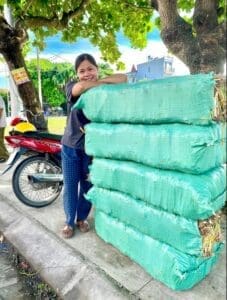
Vietnam Vetiver Farmers Group – An expanding market for small entrepreneurs (Facebook – 9.9K members)
As demand for vetiver increases, there are opportunities for small businesses producing, transporting, and selling vetiver slips. This is increasingly happening in Vietnam. This lady Hoai Nguyen, is a typical hardworking rural entrepreneur. She has a glint in her eye – looking for sales – note her well prepared and packed vetiver slips.
Quote “Grass delivery deal is a great deal!” … The situation is that Huong Hong Ha has just made the transportation fare to the central and southern provinces along national highway. The transportation fare for a sack of 2000 slips is only about 70-100k Dong (US$3-4). Before now, I was afraid to transport to Ninh Thuan, Binh Thuan, HCM provinces… Now, it’s very cheap and fast. Now I can weigh everything! Small and large orders, I guarantee the quality of the plants“
If you browse the Vietnam Vetiver Farmers Group Facebook page you will generally see well prepared quality vetiver slips and good planting techniques. Of course the Vietnamese are natural gardeners – they know that if they apply good practice they will nearly always get good results.
Pacific Islands Vetiver Community Facebook 1.2K members
This group is headed by Robinson Vanoh, of Papua New Guinea and TVNI Board member. Also Managing Director of Eagle Vetiver Systems Ltd.
Cook Islands: Mitigation of septic tank effluent
Great progress from Andy Kirkwood (Cook Islands), focusing on enhancing the sustainability of our town section by incorporating VGT into domestic septic systems. “With the area being quite dry, steps are being taken to conserve water by utilizing vetiver mulch. It’s a fantastic natural resource that not only conserves moisture in the soil but also protects the plant from over heated soils and enriches soil over time. Why Vetiver? Vetiver is a powerhouse when it comes to soil stability and erosion prevention. Its deep roots act as natural anchors and purifies water making it the perfect choice for safeguarding our septic systems. Plus, it’s resilient in dry conditions, requiring minimal water!”

Andy writes
“Vetiver for Waste Water: The East Park planting for Te Tau Papa O Avarua Project is performing well. The planting site is opposite the Banana Court in Central Avarua. This is of the treatment mound after the second trimming – planting was Nov 2023. The vetiver hedgerows are stabilizing the disposal area and intercepting nutrient flows that would otherwise seep into the Vakapurangi stream and Avarua / Trader Jack’s recreational coastline. In turn, this will prevent any increase in taramea / crown of thorns starfish population. The taramea negatively impact the reef. Elevated nutrient levels led to increased spawning. The key challenge for the planting is the elevated level of soil salinity due to storm surges over-topping the boundary boulder banks along the south-east corner. At times, the salt water is unable to drain due to the high water table. To mitigate impact, the affected hedgerows have been double-planted, mulched, and received an application of aged chicken manure. Long-term this pilot might be extended further inland, toward the area earmarked for the new central government building / MFEM. With occupancy projected at over 400 public servants – and a location only 5m above sea level – effective wastewater management is critical to minimizing the environmental impact of the proposed development.
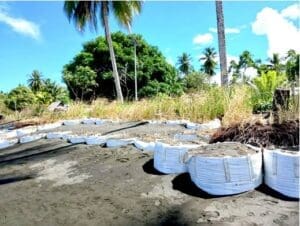
Papua New Guinea Robinson Vanoh — Building community resilience against coastal erosion – giving back to the community.
From Bonita Duba – Post Chronicle. “Saving your sandbanks and beachfront to ensure that your houses and gardens don’t get washed away is a cause for concern in PNG. We have all heard and have been told that climate change is real and is the cause for coastal areas and outlying islands losing soil due to erosion. Now a company in Morobe is fighting back. The locals of Bukawa just outside Lae have started the coastal erosion project at Bukawa. And they are using the Vetiver grass to fight erosion. This is already causing problems for the guest house owners of Kapa Kona guest house. Further effects of coastal erosion is loss of land, and coastal flooding which can lead to the destruction of agriculture land, ecology, and buildings. The people had to come up with a solution to save their coastlines. Davina Ilumpui, who is in charge of Connect Local PNG, had decided to help the guest house owners and the local people with a cheap way of retaining soil. With the help of the Managing Director of Eagle Vetiver Systems Limited, Robinson Vanoh, who was able to provide a nature-based solution to the problem instead of building a sea wall. Robinson suggested that they use Vetiver grass. If these grasses were planted along the coast, they would form a network of roots that would maintain, enhance and stabilize the soil. This project was called VETIVER Coastline Erosion Project and it started in 2023 Nestle had also come on board to help the locals by donating 100 old bags that the locals could use to fill with sand and plant the grass creating a wall, a nursery for 300 plus seedlings has also been planted in January. They had planted the grass in 31 sling bags. Eagle Vetiver Systems Ltd provided the sprouts of Vetiver grass for the locals“.
Fiji – Preventing and Mitigating Soil Erosion through community action

The concept of using Vetiver grass for soil and water conservation purposes instead of conventional structures was first developed for the sugar industry in Fiji more than 50 years ago. The Vetiver system is now widely used as a standard practice for soil and water conservation, particularly on small farms and compounds. TVNI’s Robinson Vanoh has been instrumental in providing technical support.
Vetiver grass is widely used in Fiji from simple road embankment and stream bank stabilisation, to contour hedges in farmland. it is a common practice for farmers to plant Vetiver to stabilize farm roads, to spread and slow down runoff water, and most often on contour lines to protect their vegetable crops from rill erosion. The Ministry of Agriculture and Waterways in collaboration with Live and Learn Fiji has been supporting Atoll Food Futures program, in planting Vetiver grass to sustain the negative effects of climate change to the environment. The activities are mostly carried out in the informal settlements of Kilikali, Mataniborosisi, Waikerekere and Bilo along the Suva corridor. Most of these communities face a lot of challenges due to the changing weather which has also impacted the soil and streams running along their homes and in their communities. The Ministry’s Land Use Section has been playing an instrumental role in soil erosion control and soil stabilisation, whereby Vetiver grass, is used to form dense narrow hedges when planted close to each other. Secondly, Vetiver grass is used to slow down water flow preventing channel formation and also plays a significant role in soil improvement and restoration which in turn reduces soil erosion. Climate change, unfortunately is here to stay as it is a natural phenomenon caused by various elements and can only be mitigated by nature-based solutions like planting of Vetiver amongst other solutions.
Wastewater treatment using the Vetiver System looking back at the Watts Bridge (Queensland) application.
One of Paul Truong’s earliest application of vetiver for wastewater treatment was at Watts Bridge airfield where a a vetiver constructed wetland was designed and applied circa 2008. The system, now 16 years old, is still operating today (2024) and has expanded to 4 cells (see green pin in photos) to cope with the increased effluent flows from the airfield.


Looking to get your message seen by millions without high expenses? More Info: http://lgvsd8.form-blasting.online
The Mt Apo farm road as a storm water collector video makes a great counterpoint to Binod Neupane’s Kathmandu-Terai/Madhesh Expressway work in Nepal. Binod’s work shows how a poorly designed/completely lacking road drainage system, like the one at Mt. Apo, can be retrofitted with Vetiver to create the stable, safe and controlled drainage system that appears in Binod’s video.